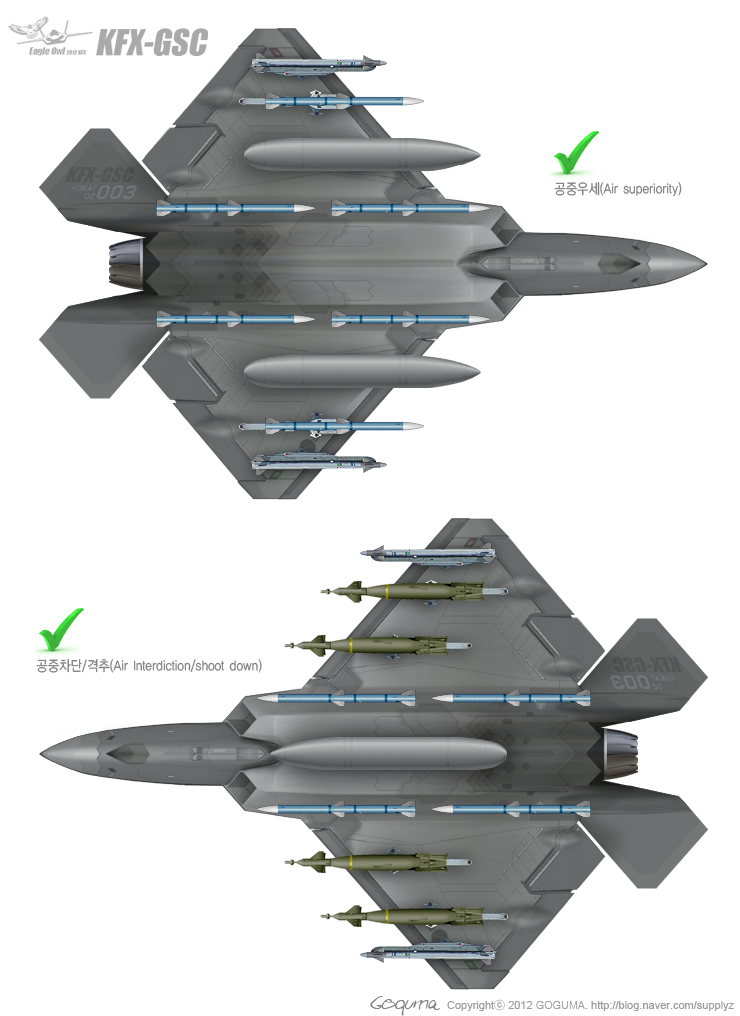Korea's KF-X Fighter Taking Shape, Final Design Due in 2018
(Source: The Korea Herald; published July 13, 2017)

Researchers of Hanwha Systems check the first prototype of an active electronically scanned array (AESA) radar for the KF-X fighter at the company’s research center in Yongin, Gyeonggi Province. (DAPA photo)
South Korea will complete the design of its own advanced fighter jet by the first half of next year, with another key task well under way to develop an AESA radar system in the KF-X project, the country's arms procurement agency said Thursday.
South Korea floated a plan in the 2000s to replace the Air Force's aging fleet of F-4 and F-5 jets, and formally launched the 8.8 trillion-won ($7.7 billion) KF-X program in early 2016. Indonesia is a junior partner, sharing 20 percent of the total cost.
The Defense Acquisition Program Administration aims to round off the aircraft development by 2026 for two years of test operations to follow. It plans to introduce some 120 KF-X fighters.
"We are working on the shape design. It will be done by June 2018," a DAPA official said. "It will be final. There is little chance of a change."
South Korea is also focusing on developing an indigenous AESA radar, a core element for the envisioned 4.5-generation stealth combat jet. AESA stands for active electronically scanned array.
In 2016, the state-run Agency for Defense Development signed a contract with Hanwha Thales, a local defense firm later renamed Hanwha Systems, for the manufacturing of the radar. The ADD has a separate deal for assistance from Israel's Elta Systems on testing a prototype.
Hanwha said it has produced the first prototype of the radar meant to demonstrate whether it's able to proceed with the development of a system suitable for KF-X jets.
South Korea is also seeking to purchase major weapon systems for the KF-X aircraft, especially for air-to-air engagement, from the United States or Europe.
The US, however, has been reluctant to provide information on some high-profile weapons, officials said.
(ends)
Prototype of KF-X Jet Radar Unveiled
(Source: Korean Observer; published July 13, 2017)
Korean defense company Hanwha Systems unveiled its first prototype of a radar system for the country’s self-developed fighter jets, Thursday.
The first prototype, comprised of an antenna and power supply, has been produced to verify whether or not the nation is able to go forward with the development of active electronically scanned array (AESA) radar with domestic technology, according to the Agency for Defense Development (ADD).
The development of AESA radar is part of the 8.5 trillion won ($7.5 billion) KF-X project to build 4.5-generation indigenous fighters by 2026 to replace the Air Force’s aging fleet of F-4s and F-5s. The government will invest an additional 10 trillion won ($8.8 billion) to produce 120 aircraft by 2032.
The ADD is supervising the development of the radar, essential equipment that helps a pilot identify friend or foe in battle and finds targets on the ground.
Hanwha Systems, previously Hanwha Thales, was selected in April last year to manufacture the radar system.
The company showed the prototype to journalists at its research center in Yongin, Gyeonggi Province, during which it gave a demonstration of a transmitting electric wave.
“Based on the first prototype, we will continue to work to develop the final version the KF-X will be equipped with,” said an ADD official, asking not to be named.
The official noted that a committee meeting was held June 28 and 29 to check whether to proceed with domestic development.
“The committee members concluded that the nation can consistently proceed with development,” he said.
The ADD plans to send the first prototype to Israel’s Elta Systems, which signed a deal on technical assistance, for ground and air trials in September.
The official added that the agency, together with the defense arm of Hanwha Group, is also developing software for the radar system.
The Defense Acquisition Program Administration (DAPA), which is overseeing the KF-X project, earlier noted that once the AESA radar is developed, it will be integrated with the KF-X in cooperation with Korea Aerospace Industries (KAI), the nation’s sole aircraft manufacturer that signed the KF-X contract with DAPA.
Seoul was originally planning to receive AESA radar technology from U.S. defense giant Lockheed Martin, but the plan foundered after the U.S. government decided to block Lockheed from transferring four core technologies used in F-35 fighter jets ― infrared search and track, electronic optics targeting pod, radio frequency jammer and AESA radar ― to Korea for security reasons.
Following that hitch, DAPA said it would develop the technologies domestically.
But some critics still express skepticism about the feasibility of domestic development.
-ends-













